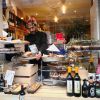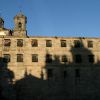- Accede I
- Regístrate I
- carrito
7. Postres conventuales
Muy cercano a la Praza de Cervantes está el Convento de San Paio de Antealtares, fundado en el s. X y ocupado desde el s. XV por benedictinas de clausura. Bajando por la calle del mismo nombre se llega a su Portal de la Borriquita, que da entrada al torno conventual. Allí pueden comprarse almendrados, tartas de Santiago, pastas y pasteles de hojaldre elaborados por las madres. Y es que con ésta y otras órdenes religiosas llegaron a Santiago hace cientos de años los postres que hoy son tradicionales, justamente aquellos que, como la tarta de Santiago, combinan almendras y yemas.
En los postres compostelanos, por Carnaval, reinan las muy gallegas ‘filloas’, crêpes de sartén que se consumen con azúcar o miel, rellenas de crema, nata o chocolate… y en algún bar, como en la alta montaña, rellenas de chorizo, tocino o morcilla. Alrededor del Carnaval también se toman las ‘orellas’, porciones de masa de harina y huevos frita en la sartén.



















